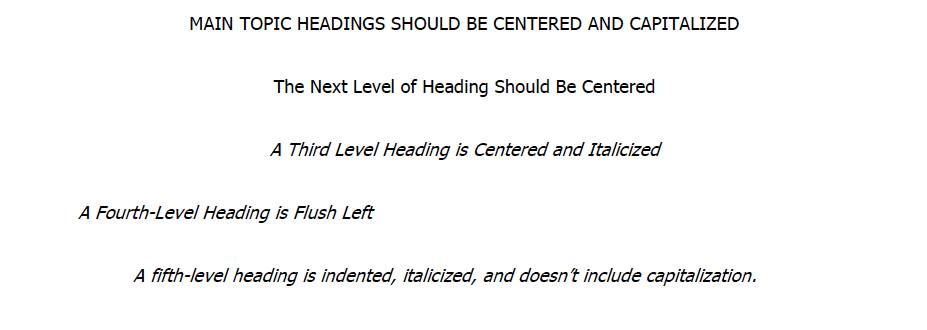Headings
Regardless of whether you are writing in APA or MLA format, you can (and perhaps should!) use headings throughout your document to break up information. In certain disciplines—such as business, engineering, nursing, social work, and psychology—writers commonly use headings.
Headings are single words, short phrases, or complete sentences that cover all of the material under it until the next heading. Headings tell the reader what to expect in each section. Not sure how headings would look on the page? Well, examine this document. The headings appear in bold, flush left to the side of the page. Take note of how they orient you, the reader, to each section of this handout.
Benefits of Using Headings
Integrating headings into your writing can be effective for several reasons:
- Breaking up information into manageable, focused chunks of text makes for an easier read.
- Dividing information into sections—and “titling” each section with a heading—can help to keep you, the writer, organized as you write and revise the document.
- By skimming through the document and looking especially at the headers, readers can glean the gist of your document. In business and scientific settings, this is a real plus because when readers come back to your document, they can simply examine the headings to find the section with the information they need at that moment.
Some Tips for Writing with Headings
Writing with headings isn’t tricky—it’s easy, in fact!—but you should consider the following:
- You wouldn’t use a heading for each paragraph in your document; rather, you would use headings for each section within your document. Each header might have several paragraphs beneath it.
- Each heading should accurately describe/signal the focus of the information beneath it.
- In some circumstances, such as in writing business reports, talking headers are best. These are headings that say more than “Background,” “Methodology,” “Conclusion.” Rather, talking headers describe in more detail the information being previewed. Consider the following headers within a report about disciplining two year-olds:
- Problems
- Techniques
- Tips
- Resources
Those headers don’t tell much of a story, do they? They don’t “speak” to readers very well. By contrast, consider these headers for the exact same report:
- Common Discipline Problems
- Techniques for Disciplining the Strong-Willed Toddler
- Tips for Disciplining with Love and Logic
- Resources for Further Study
Don’t they give a better, more complete overall picture of the report? Don’t you, simply by reading the headers, know more about the report than you could ever know from the previous set of headers?
- In some disciplines, such as in the sciences and social scientists, faculty might prefer that you stick with standard, non-talking headings like “Introduction,” “Background,” “Methodology,” “Conclusions,” and “Implications.”
- Whether headings should be centered or flush left, bolded or italicized, depends on the style guide you are using. In APA style, for example, the position of a heading indicates to readers whether it’s a major topic or a sub-topic of the document. In APA style,

To view or print our Helpful Handout, click here: Headings
*comes with learning comic attached
Have other questions? Stop in and visit! Or call us at 331-2922.
[1726082679].jpg)

